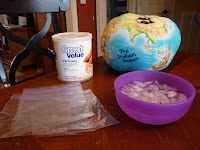Polar Bears
Polar bears are only found in the arctic region at the top of the globe. This region isn't made of land, but rather large, thick sheets of ice that float on the Arctic Ocean. Winter lasts for 6 months in the Arctic (due to the tilt of the Earth's axis away from the sun). That's a lot of cold. Polar bears have adapted (also a great science term) to life in this extreme environment.
How polar bears keep warm- Polar Bear are covered in fur that is hollow. Hollow fur traps air which is warmed by the sun. Trapping air to keep keep warm (or cool) is called insulation. To help absorb the sun's warm, polar bears have black skin under all that fur. Look closely at the picture above, especially Mama Bear's nose. You can see the black skin showing through a little bit. In addition to fur and dark skin, polar bears have a thick layer of fat called blubber that helps insulate them from the cold. Let's see how blubber helps keep polar bears warm.
- Shortening (I have been told any "fat" will work, but this is the only one I tested)
- Resealable Bags
- Ice
- Globe or Map
Fill a large resealable bag with as much shortening as you can fit in there (or have on hand). Fill a resealable bag with ice.
 | ||||
| Your Blubber |
 | ||
| Brrrrr |
Blubber helps polar bears stay warm, even in the water when they are hunting seals. Polar bears eat seals and other arctic animals such as foxes and hares. Animals that only eat meat are called carnivores. Polar bears are large animals and one hunting advantage other scientists have noticed is that their white fur allows them to blend in with the snow. When an animal blends in with its surroundings, that is called camouflage. It's much easier to sneak up on another animal if they can't see you.
For more kid friendly information, check out:
- Ice is Nice, by Bonnie Worth
- National Geographic Creature Feature: Polar Bears
- Polar Bear Facts from Defenders of Wildlife


My daughter was so excited to learn about polar bears today! She came home telling me all about them! What a fun experiment!
ReplyDeleteGlad she had fun
ReplyDelete